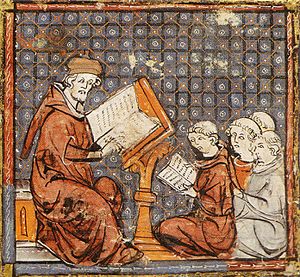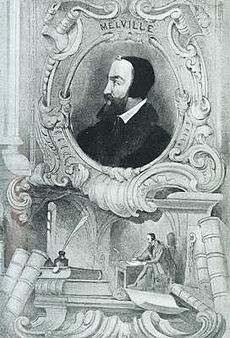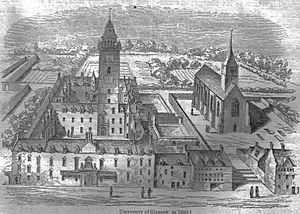Education in early modern Scotland facts for kids
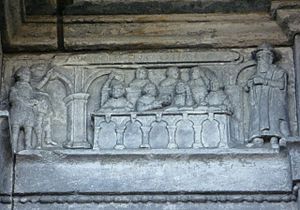
Education in early modern Scotland covers all learning in Scotland from the late 1400s to the mid-1700s. This was a time of big changes, like the Protestant Reformation and the start of the Enlightenment.
During this period, different types of schools appeared. These included grammar schools, smaller "petty schools," and even "sewing schools" for girls. Richer children often had private teachers at home. Scotland also had three universities, but their courses were quite basic. Many Scottish students went to other countries to continue their studies. These trips helped bring new ideas, like Humanism, back to Scotland. Humanism focused on learning from ancient texts and led to important laws like the Education Act 1496.
After the Reformation, education became very important for religious reasons. The Church of Scotland (called the "Kirk") tried to set up schools in every parish. A new university opened in Edinburgh, and the older universities improved a lot thanks to Andrew Melville. In the 1600s, more efforts were made to fund and organize parish schools. The university system also grew. By the early 1700s, most areas in the Lowlands had parish schools. However, the Highlands still needed more schools, so groups like the Society in Scotland for Propagating Christian Knowledge helped. Scotland's strong university system helped produce famous thinkers of the Enlightenment, such as Francis Hutcheson, Colin Maclaurin, and David Hume.
Contents
Understanding Early Schools in Scotland
How Schools Began
It's hard to find much information about schools in Scotland before the 1500s. We mostly learn about them from old town records or church documents. In the Highlands, there were signs of Gaelic education for poets and doctors.
By the end of the Middle Ages, most large churches likely had "song schools." These were open to all boys and taught singing for church services. Grammar schools, which taught Latin, were found in all major Scottish towns. Education was usually better in towns. In the countryside, "petty schools" offered basic lessons.
Most schools were for boys. However, by the late 1400s, Edinburgh had schools for girls. These were often called "sewing schools," suggesting they taught sewing. But girls probably learned reading there too. These schools were usually run by women. Wealthy families also hired private teachers. Sometimes, these private lessons grew into "household schools" that included children from nearby families. We know of about 100 different schools before the Reformation.
The Education Act 1496 was a big step. It said that sons of important landowners should go to grammar schools. This law showed the growing interest in Humanism and learning "perfect Latin." More people became able to read and write, especially wealthy men. About 60% of noblemen could read by the early 1500s.
Scotland's First Universities
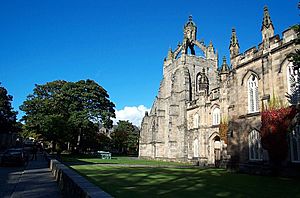
Universities started appearing across Europe from the late 1000s. They were places for learning about subjects like theology, math, law, and medicine. By the 1400s, universities were greatly influenced by Humanist ideas. Humanism focused on ancient Greek and Roman writers. It also encouraged new ways of thinking and teaching new subjects, like Greek.
Scotland's first universities were founded in the 1400s:
- St John's College, St Andrews (1418)
- St Salvator's College (1450)
- Glasgow (1451)
- King's College, Aberdeen (1495)
- St Leonard's College (1511)
At first, these universities mainly trained church leaders. But more and more ordinary people started attending. This helped them get important jobs in government and law, which used to be only for church officials.
Scottish universities mainly taught in Latin. Their courses were for future church leaders and lawyers. They didn't teach Greek, which was key to new Humanist studies. They focused on metaphysics (ideas about existence) and largely followed the teachings of Aristotle. Students could only get basic degrees. If they wanted more advanced degrees, they had to study abroad. Many Scots went to universities in other European countries or England. These international connections helped bring new Humanist ideas to Scotland. For example, Hector Boece, a Humanist who studied in Paris, became the first head of the new University of Aberdeen in 1497.
Education in the 1500s
Humanism and the Reformation
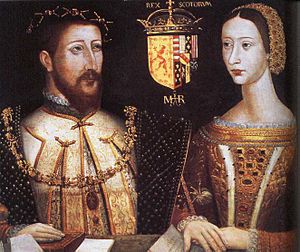
Humanism taught important values like order and good behavior. These ideas greatly influenced schools and universities by the end of the 1500s. King's College Aberdeen was re-established in 1515. It offered theology, law, and medicine, in addition to arts. St Leonard's College was founded in Aberdeen in 1511. St Mary's College, St Andrews was re-established in 1538 as a Humanist school for training church leaders, focusing on Bible study.
In the 1520s and 1530s, Robert Reid brought an Italian Humanist, Giovanni Ferrario, to teach at Kinloss Abbey. Ferrario created a great library there and wrote about Scottish history. Reid also helped set up public lectures in Edinburgh in the 1540s. These lectures covered law, Greek, Latin, and philosophy, supported by Queen Mary of Guise. These lectures eventually grew into the "Tounis College," which later became the University of Edinburgh.
In the mid-1500s, Scotland had a Protestant Reformation. This meant rejecting the Pope's authority and many Catholic beliefs. Scotland became a mostly Calvinist country with a Presbyterian church called the "kirk." This new church gave local landowners (called lairds) a lot of power. They often helped choose church leaders and were important in starting and funding schools. The focus in religion shifted from rituals to understanding the Bible. This made reading the Bible, and therefore learning to read, very important.
Changes in Schools
Protestant reformers, like Humanists, wanted more people to have access to education. They believed schools could teach good morals and religion. After the Protestants gained power in 1560, the First Book of Discipline suggested a school in every parish. But this was too expensive.
In towns, existing schools mostly continued. Song schools became reformed grammar schools or regular parish schools. Schools were paid for by church funds, local landowners, town councils, and parents who could afford it. Local church leaders (called kirk sessions) checked the teaching quality and religious beliefs.
There were also many private "adventure schools." These were often started informally by parents hiring unlicensed teachers. They are mostly known from complaints by kirk sessions because they took students away from official parish schools. However, these private schools were often needed in large parishes. The church often quietly accepted them. They might have been especially important for girls and poor children.
Outside of the well-funded town schools, teachers often had other jobs, like minor church roles. Right after the Reformation, there weren't enough teachers. But by the 1600s, the growing university system produced many graduates. We know of about 800 schools between 1560 and 1633. Parish schools taught in the local language ("Inglis") for children up to about age 7. Grammar schools took boys up to about age 12. At their best, grammar schools taught the catechism (religious instruction), Latin, French, classic literature, and sports.
People at the time often thought women had limited intelligence. But after the Reformation, there was a stronger desire for women to be more responsible, especially as wives and mothers. This meant they needed to learn and understand the catechism and even read the Bible themselves. However, most people still believed girls should not get the same academic education as boys. Girls were only allowed in parish schools if there weren't enough boys to pay the teacher.
In poorer families, girls benefited from the new parish schools. But they were usually fewer in number than boys. They were often taught separately, for less time, and at a lower level. Girls often learned reading, sewing, and knitting, but not writing. Among noble families, many women were well-educated and cultured, like Mary, Queen of Scots.
University Reforms
After the Reformation, Scottish universities changed a lot, thanks to Andrew Melville. He returned from Geneva in 1574 to become the head of the University of Glasgow. Melville was a brilliant linguist, philosopher, and poet. He had studied in Paris and Geneva.
Melville was influenced by a thinker named Petrus Ramus. He simplified logic and gave languages and sciences the same importance as philosophy. This allowed old ideas in all subjects to be questioned. He brought in new specialist teachers, replacing the old system where one teacher taught students all subjects. Old ideas about metaphysics were dropped. Greek became a required subject in the first year, followed by other ancient languages like Aramaic, Syriac, and Hebrew.
Before Melville, student numbers at Glasgow University were falling. But after his changes, many students enrolled. He also helped rebuild Marischal College in Aberdeen, which became a second university college in the city in 1593. To bring similar improvements to St Andrews, he became head of St Mary's College, St Andrews in 1580. The "Tounis College" in Edinburgh became the University of Edinburgh in 1582. Melville's reforms made Scottish universities excellent places of learning, as good as any in Europe.
Education in the 1600s
Parish Schools Grow
In 1616, a law from the Privy Council ordered every parish to set up a school "where convenient means may be had." The Parliament of Scotland approved this law and the Education Act 1633. A tax on local landowners was then introduced to pay for these schools.
From 1638, Scotland went through a "second Reformation." Many people supported a National Covenant, disagreeing with King Charles I's church changes. They wanted to stick to the Calvinist and Presbyterian ways of the kirk. After the Bishop's Wars (1639–40), Scotland became almost independent from England. Education remained very important to the Covenanters (those who signed the Covenant).
A loophole that allowed people to avoid the education tax was closed by the Education Act 1646. This law created a strong system for schools based on Covenanter ideas. It gave local church groups (presbyteries) a key role in overseeing schools. Although the Restoration of the monarchy in 1660 brought back the 1633 rules, new laws in 1696 restored the 1646 rules. These new laws also added ways to make sure schools were set up in every parish.
In rural areas, these laws made landowners (heritors) provide a schoolhouse and pay a teacher, known as a dominie. Church ministers and presbyteries checked the quality of education. In many Scottish towns, local councils ran "burgh schools." By the late 1600s, most of the Lowlands had a network of parish schools. But in the Highlands, many areas still lacked basic education.
Universities Expand
During the time of the Commonwealth (1652–60), universities received more money. They got income from church lands and taxes. This allowed them to finish buildings, like the college on High Street in Glasgow. Universities were still mainly seen as places to train church leaders. They came under the control of strict Presbyterian groups who were favored by the government. For example, Patrick Gillespie became the head of Glasgow University in 1652.
After the Restoration in 1660, many Presbyterians were removed from universities. But most of the academic progress made earlier was kept. Scotland's five universities recovered from the civil war years. They offered a lecture-based curriculum that included economics and science. This provided a high-quality education for the sons of nobles and gentry. All universities created or brought back chairs (professorships) in mathematics. Astronomy was helped by building observatories at St Andrews and at King's and Marischal colleges in Aberdeen. Robert Sibbald became the first Professor of Medicine at Edinburgh. He also helped start the Royal College of Physicians of Edinburgh in 1681. These changes helped universities become major centers for medical education. They also put Scotland at the forefront of new ideas during the Enlightenment.
Early 1700s Education
Challenges in the School System
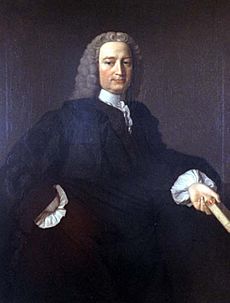
The widespread network of parish schools led to a belief called the "democratic myth." This idea, popular in the 1800s, suggested that many talented boys could rise from humble beginnings to high positions through education. It also claimed that more people could read and write in Scotland than in nearby countries like England.
Today, historians know that very few boys actually achieved social advancement this way. Also, literacy rates in Scotland were not much higher than in other similar countries. This is because the education in parish schools was basic and short, and attending school was not required.
By the 1700s, many poorer girls were taught in "dame schools." These were informal schools often set up by a widow or single woman. They taught reading, sewing, and cooking. Among wealthy families, girls were expected to learn basic reading, writing, math, needlework, cooking, and household management. Good manners and religious devotion were also important.
Around the late 1600s and early 1700s, about 90% of female servants could not sign their names. By 1750, about 85% of women of all social classes could not read or write, compared to 35% of men. Overall, Scotland had slightly higher literacy rates than England. However, Scottish women's literacy rates were much lower than English women's.
In the Highlands, popular education faced challenges. These included long distances, isolation, and teachers who didn't know much Scottish Gaelic, the main local language. The Kirk's parish schools were helped by schools started in 1709 by the Society in Scotland for Propagating Christian Knowledge (SSPCK). The SSPCK wanted to teach English in the Highlands. They also aimed to reduce support for Roman Catholicism, which was linked to rebellious Jacobitism. Although SSPCK schools eventually taught in Gaelic, their overall effect contributed to the decline of Highland culture. Literacy rates were lower in the Highlands than in the Lowlands. Despite these efforts, many people in the Highlands still could not read or write well into the 1800s.
The Start of the Enlightenment
Access to Scottish universities was probably more open than in England, Germany, or France at the time. Attending university was cheaper, and students came from a wider range of social backgrounds. In the 1700s, Scotland benefited greatly from this system. It made important contributions to the European Enlightenment.
Key figures in the early Scottish Enlightenment included:
- Francis Hutcheson (1694–1746): He was a professor of moral philosophy at Glasgow from 1729 to 1746. He helped develop ideas like Utilitarianism (the greatest good for the greatest number) and Consequentialist thinking.
- Colin Maclaurin (1698–1746): He became a professor of mathematics at Marischal College at age 19. He was the leading British mathematician of his time.
- David Hume (1711–76): He was perhaps the most important thinker in early modern Scotland. His books, Treatise on Human Nature (1738) and Essays, Moral and Political (1741), helped define philosophical Empiricism (knowledge from experience) and Scepticism (questioning beliefs). He greatly influenced later Enlightenment figures like Adam Smith and Immanuel Kant.
|


